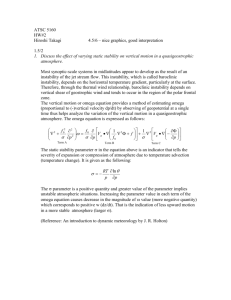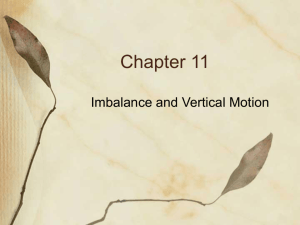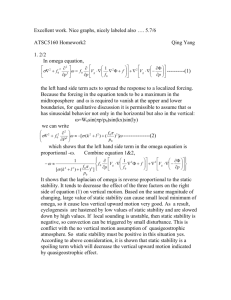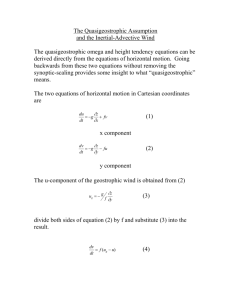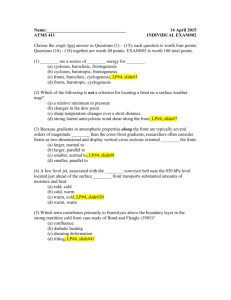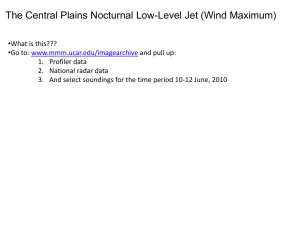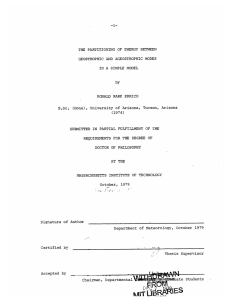Document 7690199
advertisement
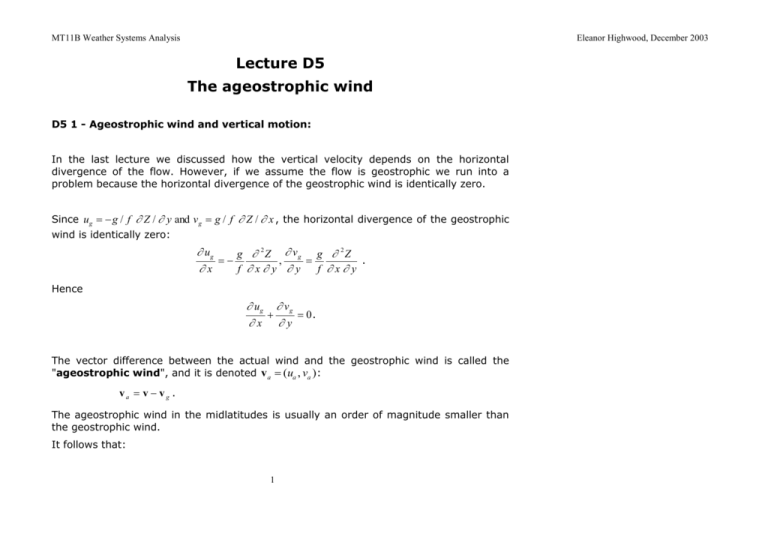
MT11B Weather Systems Analysis Eleanor Highwood, December 2003 Lecture D5 The ageostrophic wind D5 1 - Ageostrophic wind and vertical motion: In the last lecture we discussed how the vertical velocity depends on the horizontal divergence of the flow. However, if we assume the flow is geostrophic we run into a problem because the horizontal divergence of the geostrophic wind is identically zero. Since ug g / f Z / y and v g g / f Z / x , the horizontal divergence of the geostrophic wind is identically zero: ug g 2 Z vg g 2 Z , . x f xy y f xy Hence ug v g 0. x y The vector difference between the actual wind and the geostrophic wind is called the "ageostrophic wind", and it is denoted v a (ua , va ) : va v vg . The ageostrophic wind in the midlatitudes is usually an order of magnitude smaller than the geostrophic wind. It follows that: 1 MT11B Weather Systems Analysis Eleanor Highwood, December 2003 D u v ua va . x y x y p The vertical velocity therefore depends upon the small ageostrophic part of the wind field. Also, by considering the tendency equation derived in the last lecture, changes in surface pressure also depend directly on the ageostrophic wind. D5 2- Acceleration of air parcels: Consider the acceleration of an air parcel. Away from the ground, we may neglect friction. The acceleration is then simply the sum of the Coriolis and pressure gradient forces. For the x-component of the wind: Du Z . fv g Dt x But the definition of the geostrophic wind is: fv g g Z . x Substituting into the equation of motion: Du Dv fva , similarly fua . Dt Dt These equations show that any acceleration of the fluid parcel is a direct consequence of the ageostrophic wind. If the wind were exactly geostrophic, no acceleration, and hence no evolution of weather systems could take place. Small ageostrophic wind components are of crucial interest to meteorologists and can be useful in working out where there is likely to be vertical motion. Let’s have a closer look at two examples of this. 2 MT11B Weather Systems Analysis Eleanor Highwood, December 2003 D5 3 - An upper jet exit: Consider a jet exit with the jet axis being oriented in the zonal direction in the upper troposphere. 1. As the parcel moves from A towards B, it is deccelerating. 2. The momentum equation tells us that the ageostrophic wind must therefore be directed to the south, as shown. Away from the jet exit, the ageostrophic wind will be small: thus there will be convergence of the ageostrophic wind to the south of the jet exit and divergence of the ageostrophic wind to the north of the jet exit. By continuity, at lower levels in the troposphere, we expect to see descent to the south of the jet exit and ascent to the north of the jet exit. Exactly the opposite pattern of ascent and descent will occur in a jet entrance region. These regions of ascent favour the development or deepening of low pressure centres, while regions of descent favour the intensification of anticyclones. These “development regions” were used by forecasters before the availability of numerical weather predictions as means of predicting the intensification or decay of midlatitude weather systems. 3 MT11B Weather Systems Analysis Eleanor Highwood, December 2003 D 5.4 Thermal advection and ageostrophic wind: z Imagine a situation where the atmosphere is initially motionless, with level pressure surfaces, shown in the diagram. p2 p1 x Now suppose warm thermal advection takes place, bringing warm air from the south locally. The lower pressure surface is supposed to remain flat, while the upper one must be elevated over the region of warming. z Looking at the slope of the p2 surface, a southerly geostrophic wind is needed to the west of the thermal advection, and a northerly geostrophic wind to the east of the warm advection region. How can these be achieved? p2 Thermal advection p1 From the equations for the acceleration given in the last section, there must be an easterly ageostrophic wind to the west of the heating and a westerly ageostrophic wind on its eastern side. There is upper level divergence of the ageostrophic wind in the centre of the region of warm thermal advection. By continuity, this implies ascent at lower levels. x z Ascent is associated with warm thermal advection. ua ua . Descent is associated with cold thermal advection. p2 Ascent p1 4 x MT11B Weather Systems Analysis Eleanor Highwood, December 2003 Worked Example: An upper tropospheric jet extends across the Atlantic at 45N. The jet core is at 30 kPa and the maximum westerly wind is 50 m s-1 above the coast of North America, declining to 15 m s-1 3000 km further east. Calculate the ageostrophic wind in the jet exit at 30 kPa, and hence estimate the vertical velocity in the jet exit region. You may assume the jet width is 1000 km. Step 1: Jet is oriented W-E so no acceleration/deceleration in y direction. Therefore Dv/Dt=0 and ua = 0 Step 2: Find va arising from deceleration in zonal direction. Remember from basic mechanics that accel=v2-u2/2s such that Du/Dt=-3.79x10-4 ms-2. Step 3: At 45N, f=1.03x10-4s-1, and Du/Dt=fva so calculate va=-3.68 ms-1. I.e. the ageostrophic wind is northerly, magnitude 3.7ms1. Step 4: Away from jet there is no ageostrophic wind. Therefore va= zero at 500km from jet core. Divergence= -(va at core)/500km = 7.4x10-6 s-1. p Step 5: pressure vertical velocity ( p) Ddp which can be adapted to 0 =-Dp=-7.4x10 x30x10 = -0.222 Pa s . -6 3 -1 Step 6: gw so w=0.02 ms-2 (assuming g=10 and =1). 5
